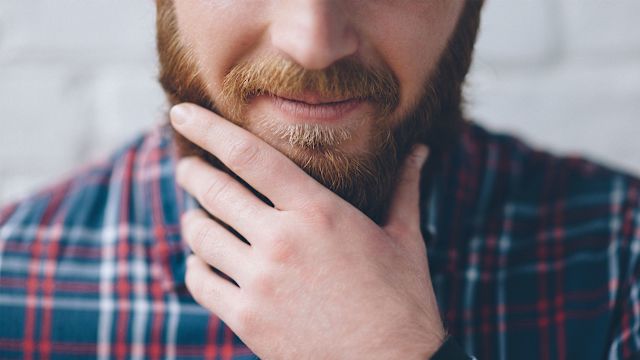Beards have come in and out of fashion for centuries. Many men just like how they look with a beard, goatee, or even a well-manicured five o’clock shadow. Others temporarily forgo shaving to raise awareness about cancer and other causes.
But beards are like sponges, picking up dust, debris, and food throughout the day. They may require some maintenance to avoid irritating issues and skin complications, like acne and ingrown hairs, according to Vinod Nambudiri, MD, an internist and skin specialist in Boston.
“The beard area is similar to the scalp, with several hair-bearing follicles in close proximity to one another, so sometimes conditions that affect the scalp hair can also affect the beard hair,” says Dr. Nambudiri. “Similarly, the beard area is very much continuous with the skin of the face.” Certain dermatological conditions that can affect the face could extend to the skin beneath your beard, he explains.
Facial hair pitfalls, explained
If you’ve got facial hair, you may confront some of the following common issues:
Dandruff
Dandruff is a mild form of seborrheic dermatitis, a skin condition that tends to affect the scalp. It may cause itching and white skin flakes to accumulate in your beard.
While there are many theories about what causes dandruff, experts don’t have a firm grasp on the root cause. But stress, hormonal changes, forgoing regular shampoos, certain weather changes, or some health conditions like Parkinson’s and the human immunodeficiency virus (HIV) may increase your risk. Sensitivity to hair dyes and other ingredients found in hair care products may also increase your chances of having dandruff.
Acne
This skin issue can develop when pores become clogged with oil and dead skin cells. Bacteria can then make their way inside, causing pores to become inflamed and pimples to form. If you have a beard, you may not shed dead skin cells as easily, which could lead to breakouts.
Ingrown hairs
Those red, raised bumps that often appear after shaving or tweezing could be ingrown hairs. They appear when hair emerges from the follicles, but curls back into the skin. Also known as pseudofolliculitis barbae, ingrown hairs may be common when you’re first growing out your beard. They can also occur when you shave your neck or around your beard as part of your trimming routine.
Irritation and itchiness
These annoying sensations can occur when you’re trimming or manicuring your facial hair. Dull razors or using products with irritating chemicals or fragrances may break down the outer layer of skin that’s meant to provide protection.
Spotty hair growth
This may be genetic, says Nambudiri. But if you have a round patch of hair loss, it may be from an underlying autoimmune condition known as alopecia areata, a form of hair loss caused by inflammation, which is often manageable, he adds.
Skin infections
You skin may become infected if you have a beard that’s not routinely shampooed and your skin is irritated and itchy. Bacteria, like Staphylococcus aureus, are normally found on the skin. But if you’re constantly scratching your beard, these germs can lead to folliculitis—an itchy and sometimes painful infection of the hair follicles—or boils, which are painful, pus-filled bumps caused by infected hair follicles. If not treated, folliculitis can lead to other more serious complications, like cellulitis, an infection that can potentially lead to other dangerous skin and blood infections.
Beware of barbershop trims: If your stylist fails to sanitize the razor, you may be more at risk for these infections.
How to avoid mishaps
Neglecting your skin or not having a daily grooming practice is the biggest mistake you can make if you have facial hair, Nambudiri cautions. The good news is that a healthy beard maintenance routine doesn’t have to be lengthy or complicated. Here are some of the ways to keep your beard in good shape:
Wash your beard daily
In an ideal world, Nambudiri recommends washing your hair every day with a gentle beard shampoo. If you’re experiencing dandruff, he suggests finding a dandruff-specific product that contains zinc pyrithione or selenium sulfide, which you should leave on your hair for 5 to 10 minutes before rinsing out.
Try washing your beard in a circular motion with a cloth, sponge or even a toothbrush for a few minutes to help free ingrown hairs. If you’re short on time and have to skip the shampoo, rinse your beard with water and make sure it dries thoroughly. Just avoid going more than several days without shampooing.
Don’t forget your skin
The skin beneath your beard shouldn’t be neglected. If you’re prone to breakouts use an over-the-counter anti-acne cream or cleanser than contains salicylic acid, benzoyl peroxide, or retinoids.
Remember to moisturize
Using a daily lotion or oil specifically formulated for beards can help alleviate brittleness and help maintain the texture of your facial hair. After you trim your beard, condition it with a few drops of oil. Pat a few drops onto your beard then comb or brush it through. This can also be done after showering. If you’re prone to acne, skip this step since excess oil could lead to breakouts.
Comb your beard regularly
Just like brushing your teeth or combing your hair, your beard should be groomed daily to prevent itchiness and irritation. Use a comb designed specifically for beards, made of either wood or horn. Using a plastic comb can lead to split ends and static.
Take note after eating
It’s easy for food particles to get trapped in your facial hair, so be sure to give your face a once-over after each meal. Removing particles promptly will prevent buildup of oils and bacteria that can lead to acne, infections and irritation, says Nambudiri.
Use caution when shaving and trimming
If you’re trimming your beard or you’re ready to lose it once and for all, practice healthy shaving habits, such as applying shave gel or cream or a warm compress to the skin to soften the hair before shaving. Opt for a single blade razor and avoid stretching the skin while shaving to help prevent ingrown hairs and irritation.
Not sure when to trim or shave? A good rule of thumb is to evaluate how it’s looking at the ends: If you notice split ends, it may be time to cut back or start over. Be sure to trim post-shower after your beard has dried.
When to see a healthcare provider
If you’ve taken steps to maintain a healthy beard but you’re still having problems with issues like acne and dandruff, talk to a healthcare provider (HCP) or dermatologist. Some underlying conditions, such as alopecia areata, may be treated with creams, injections, or oral medication, Nambudiri explains.
If you notice any inflamed areas or tender spots (especially if you have a fever), it’s also important to see your HCP to rule out or treat severe infections and other more serious concerns.






